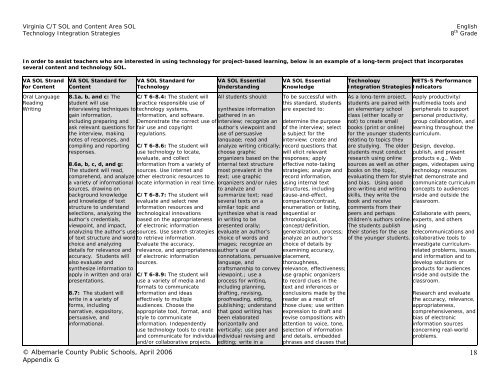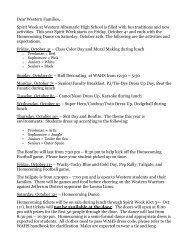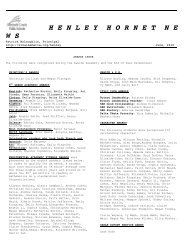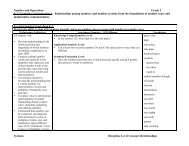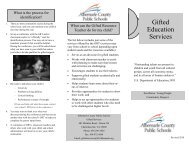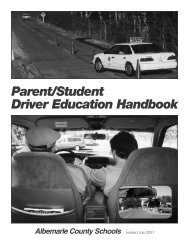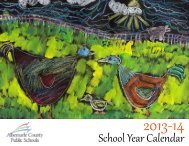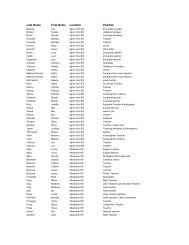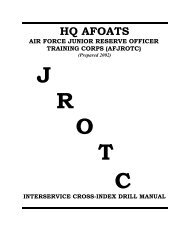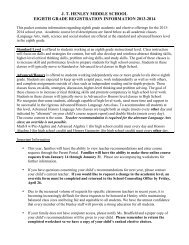Language Arts/English Curriculum Frameworks - Albemarle County ...
Language Arts/English Curriculum Frameworks - Albemarle County ...
Language Arts/English Curriculum Frameworks - Albemarle County ...
You also want an ePaper? Increase the reach of your titles
YUMPU automatically turns print PDFs into web optimized ePapers that Google loves.
Virginia C/T SOL and Content Area SOL <strong>English</strong><br />
Technology Integration Strategies 8 th Grade<br />
In order to assist teachers who are interested in using technology for project-based learning, below is an example of a long-term project that incorporates<br />
several content and technology SOL.<br />
VA SOL Strand<br />
for Content<br />
Oral <strong>Language</strong><br />
Reading<br />
Writing<br />
VA SOL Standard for<br />
Content<br />
8.1a, b, and c: The<br />
student will use<br />
interviewing techniques to<br />
gain information,<br />
including preparing and<br />
ask relevant questions for<br />
the interview, making<br />
notes of responses, and<br />
compiling and reporting<br />
responses.<br />
8.6a, b, c, d, and g:<br />
The student will read,<br />
comprehend, and analyze<br />
a variety of informational<br />
sources, drawing on<br />
background knowledge<br />
and knowledge of text<br />
structure to understand<br />
selections, analyzing the<br />
author’s credentials,<br />
viewpoint, and impact,<br />
analyzing the author’s use<br />
of text structure and word<br />
choice and analyzing<br />
details for relevance and<br />
accuracy. Students will<br />
also evaluate and<br />
synthesize information to<br />
apply in written and oral<br />
presentations.<br />
8.7: The student will<br />
write in a variety of<br />
forms, including<br />
narrative, expository,<br />
persuasive, and<br />
informational.<br />
VA SOL Standard for<br />
Technology<br />
© <strong>Albemarle</strong> <strong>County</strong> Public Schools, April 2006<br />
Appendix G<br />
C/T 6-8.4: The student will<br />
practice responsible use of<br />
technology systems,<br />
information, and software.<br />
Demonstrate the correct use of<br />
fair use and copyright<br />
regulations.<br />
C/T 6-8.6: The student will<br />
use technology to locate,<br />
evaluate, and collect<br />
information from a variety of<br />
sources. Use Internet and<br />
other electronic resources to<br />
locate information in real time.<br />
C/T 6-8.7: The student will<br />
evaluate and select new<br />
information resources and<br />
technological innovations<br />
based on the appropriateness<br />
of electronic information<br />
sources. Use search strategies<br />
to retrieve information.<br />
Evaluate the accuracy,<br />
relevance, and appropriateness<br />
of electronic information<br />
sources.<br />
C/T 6-8.9: The student will<br />
use a variety of media and<br />
formats to communicate<br />
information and ideas<br />
effectively to multiple<br />
audiences. Choose the<br />
appropriate tool, format, and<br />
style to communicate<br />
information. Independently<br />
use technology tools to create<br />
and communicate for individual<br />
and/or collaborative projects.<br />
VA SOL Essential<br />
Understanding<br />
All students should:<br />
synthesize information<br />
gathered in an<br />
interview; recognize an<br />
author’s viewpoint and<br />
use of persuasive<br />
language; read and<br />
analyze writing critically;<br />
choose graphic<br />
organizers based on the<br />
internal text structure<br />
most prevalent in the<br />
text; use graphic<br />
organizers and/or rules<br />
to analyze and<br />
summarize text; read<br />
several texts on a<br />
similar topic and<br />
synthesize what is read<br />
in writing to be<br />
presented orally;<br />
evaluate an author’s<br />
choice of words and<br />
images; recognize an<br />
author’s use of<br />
connotations, persuasive<br />
language, and<br />
craftsmanship to convey<br />
viewpoint.; use a<br />
process for writing,<br />
including planning,<br />
drafting, revising,<br />
proofreading, editing,<br />
publishing; understand<br />
that good writing has<br />
been elaborated<br />
horizontally and<br />
vertically; use peer and<br />
individual revising and<br />
editing; write in a<br />
VA SOL Essential<br />
Knowledge<br />
To be successful with<br />
this standard, students<br />
are expected to:<br />
determine the purpose<br />
of the interview; select<br />
a subject for the<br />
interview; create and<br />
record questions that<br />
will elicit relevant<br />
responses; apply<br />
effective note-taking<br />
strategies; analyze and<br />
record information,<br />
using internal text<br />
structures, including<br />
cause-and-effect,<br />
comparison/contrast,<br />
enumeration or listing,<br />
sequential or<br />
chronological,<br />
concept/definition,<br />
generalization, process;<br />
analyze an author’s<br />
choice of details by<br />
examining accuracy,<br />
placement,<br />
thoroughness,<br />
relevance, effectiveness;<br />
use graphic organizers<br />
to record clues in the<br />
text and inferences or<br />
conclusions made by the<br />
reader as a result of<br />
those clues; use written<br />
expression to draft and<br />
revise compositions with<br />
attention to voice, tone,<br />
selection of information<br />
and details, embedded<br />
phrases and clauses that<br />
Technology<br />
NETS-S Performance<br />
Integration Strategies Indicators<br />
As a long-term project,<br />
students are paired with<br />
an elementary school<br />
class (either locally or<br />
not) to create small<br />
books (print or online)<br />
for the younger students<br />
relating to topics they<br />
are studying. The older<br />
students must conduct<br />
research using online<br />
sources as well as other<br />
books on the topic,<br />
evaluating them for style<br />
and bias. Using good<br />
pre-writing and writing<br />
skills, they write the<br />
book and receive<br />
comments from their<br />
peers and perhaps<br />
children’s authors online.<br />
The students publish<br />
their stories for the use<br />
of the younger students.<br />
Apply productivity/<br />
multimedia tools and<br />
peripherals to support<br />
personal productivity,<br />
group collaboration, and<br />
learning throughout the<br />
curriculum.<br />
Design, develop,<br />
publish, and present<br />
products e.g., Web<br />
pages, videotapes using<br />
technology resources<br />
that demonstrate and<br />
communicate curriculum<br />
concepts to audiences<br />
inside and outside the<br />
classroom.<br />
Collaborate with peers,<br />
experts, and others<br />
using<br />
telecommunications and<br />
collaborative tools to<br />
investigate curriculumrelated<br />
problems, issues,<br />
and information and to<br />
develop solutions or<br />
products for audiences<br />
inside and outside the<br />
classroom.<br />
Research and evaluate<br />
the accuracy, relevance,<br />
appropriateness,<br />
comprehensiveness, and<br />
bias of electronic<br />
information sources<br />
concerning real-world<br />
problems.<br />
18


